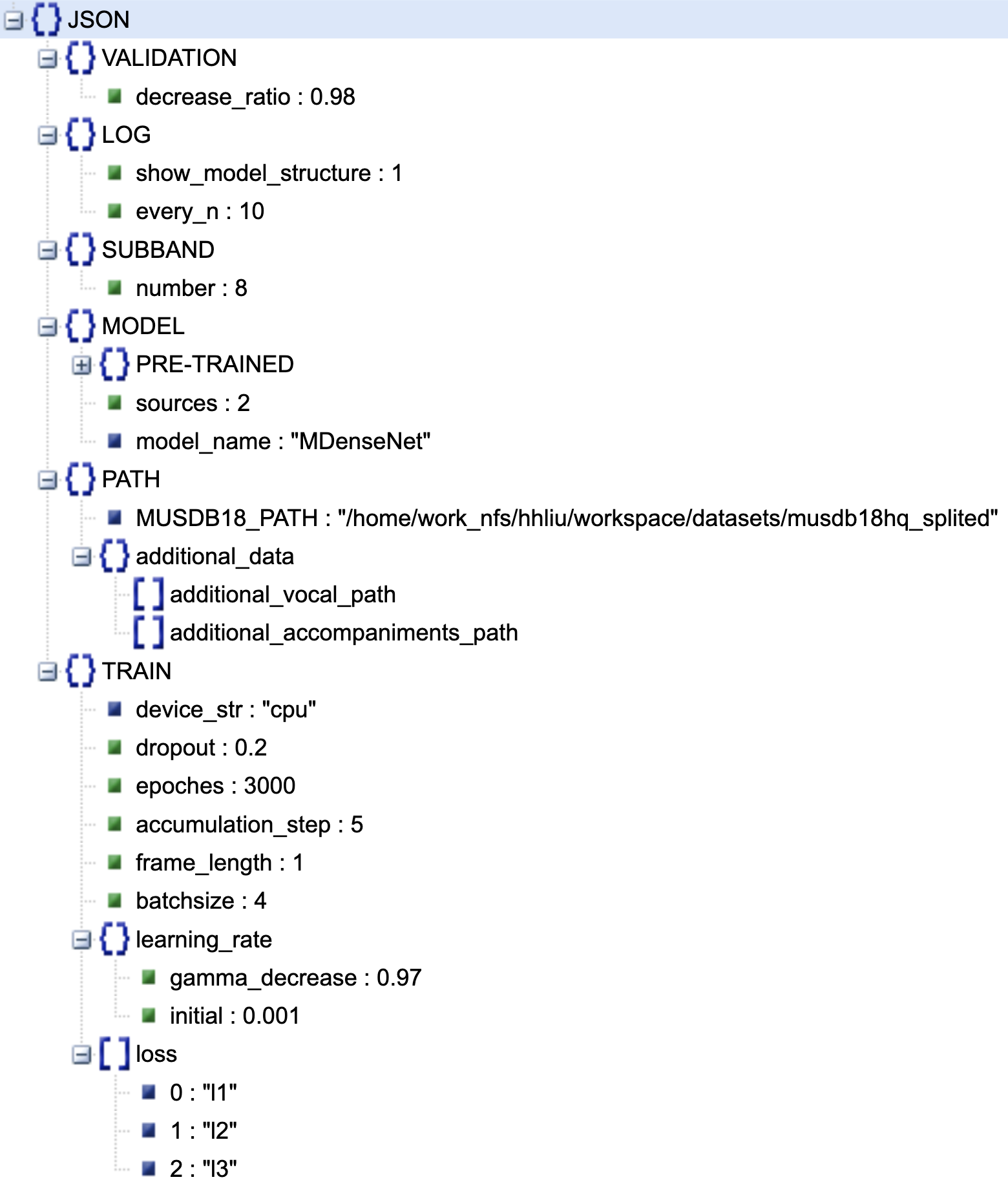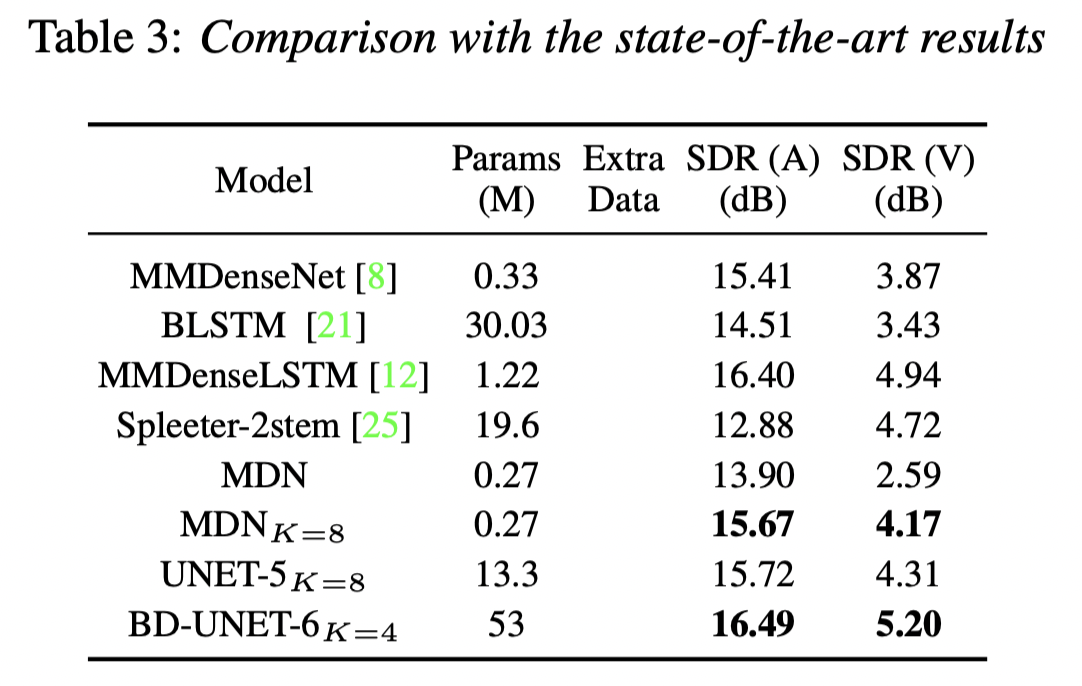Please checkout our latest MSS repo: https://github.com/haoheliu/2021-ISMIR-MSS-Challenge-CWS-PResUNet. It has much better performance.
Here is the package torchsubband I wrote for subband decomposition.
If you find our code useful for your research, please consider citing:
@inproceedings{Liu2020,
author={Haohe Liu and Lei Xie and Jian Wu and Geng Yang},
title={{Channel-Wise Subband Input for Better Voice and Accompaniment Separation on High Resolution Music}},
year=2020,
booktitle={Proc. Interspeech 2020},
pages={1241--1245},
doi={10.21437/Interspeech.2020-2555},
url={http://dx.doi.org/10.21437/Interspeech.2020-2555}
}.
This is a system for voice and accompaniment separation model training. All you need to do is configure environment, download training data and enjoy your training! If you need personalize your training, you just need to modify the configurationjson file. We also provide some examples. This repo also integrate the subband decomposation and synthesis tools mentioned in our paper: link
-
You can use MUSDB18 [1] as well as the data you have
-
You can easily try Channel-wise subband (CWS) input [2] by modify the configuration file
-
You can use model we pre-defined. You can also add model if you like!
...
-
First we configure the code running environments
git clone https://github.com/haoheliu/Subband-Music-Separation.git pip install -r requirements.txt
-
Then we download musdb18-hq data from the following website, this process might be a little bit slow.
Note: You can also use your own data, see: link
-
Next we configure the path to MUSDB18 dataset
- We open the config.json (or other config file you like)
- Modify the "MUSDB18_PATH" variable; e.g.: "/home/work_nfs/hhliu/workspace/datasets/musdb18hq_splited"
- Save file
-
Finanlly let training!
python main_separation.py config.json
You can play with some additional functions by modify the configuratoin file or use the code we provide.
-
Load pre-trained model and start training(MMDenseNet)
-
Configure model structure (examples/config_demo_pretrained.json)
-
Configure pretrained model path (examples/config_demo_pretrained.json)
"PRE-TRAINED": { "start_point": 155700, "load_model_path": "./checkpoints/1_2020_5_8_MDenseNetspleeter_sf0_l1_l2_l3__BD_False_lr001_bs16-1_fl1.5_ss4500.0_87lnu4fshift8flength32drop0.1split_bandTrue_8" },
python main_separation.py examples/config_demo_pretrained.json
-
-
Separate a song (Using MMDenseNet)
-
Put the song you'd like to split in: "./evaluate/listener_todo"
python demo_separation.py
-
-
Use additional data
-
Do configuration like below. List all the path to each of your .wav file in those txt files.
"additional_data": { "additional_vocal_path": ["addtional_data/accompaniment_list1.txt", "addtional_data/accompaniment_list2.txt"], "additional_accompaniments_path": ["addtional_data/vocal_list1.txt", "addtional_data/vocal_list2.txt"] }
-
-
Try different kinds of Channel-wise subband inputs
-
Modify the "SUBBAND-number" parameter, the value you can choose is 1,2,4,8
"SUBBAND": { "number": 8 },
-
You just need to mofidy the configuration file to personalize your experiment. This section I will lead you around the variable inside the configuration file. The content inside the configuration file is shown below:
The function of each parameter:
- LOG
- show_model_Structure: int, [1,0] 1: print model structure before training ; 0: not print
- every_n: int, Print the average loss every "every_n" batches
- SUBBAND
- number: int, [1,2,4,8], How many subband you want in CWS
- MODEL
- PRE-TRAINED: Optional, pre-trained model path, see my example below
- start_point: int
- load_model_path : str
- sources: 2, voice and accompaniment
- model_name: str, ["Unet-5","Unet-6","MDenseNet","MMDenseNet"], the model you wanna play with
- PRE-TRAINED: Optional, pre-trained model path, see my example below
- PATH
- MUSDB18_PATH: str, Root path to musdb18hq dataset
- additional_data: Optional, additional data infos
- additional_vocal_path: list
- additional_accompaniment_path: list
- TRAIN
- device_str: str, ['cpu','cuda','cuda:1',...], Specify the device you wanna use.
- dropout: float
- epochs: One epoches means 10 hours of training data
- accumulation_step: Gradient accumilation, every "accumulation_step" we update the parameters of the model. Larger "accumulation_step" equal to bigger batchsize to some sense.
- frame_length: Input frame length during training
- batchsize: int
- learning_rate
- gamma_decrease: float, 0~1, Decay rate (exponential decay)
- initial: float, Initial learning rate
- loss: list, ['l1','l2','l3'] or ['l2','l3']
- "l1" :energy conservation los
- "l2" : l1-norm on accompaniments
- "l3" : l1-norm on vocal
- VALIDATION:
- decrease_ratio: float, If validation loss drop greater than "decrease_ratio", we save model and start evaluation on musdb18 datase
- We will save model in "saved_modes/"
- We will save separation results in output
- The wav files inside "evaluate/listener_todo" are considered songs to be splitted. (separation_util.py: SeparationUtil.split_listener())
[1] Z. Rafii, A. Liutkus, F.-R. St¨oter, S. I. Mimilakis, and R. Bittner, “Musdb18-hq - an uncompressed version of musdb18,” Aug. 2019.



